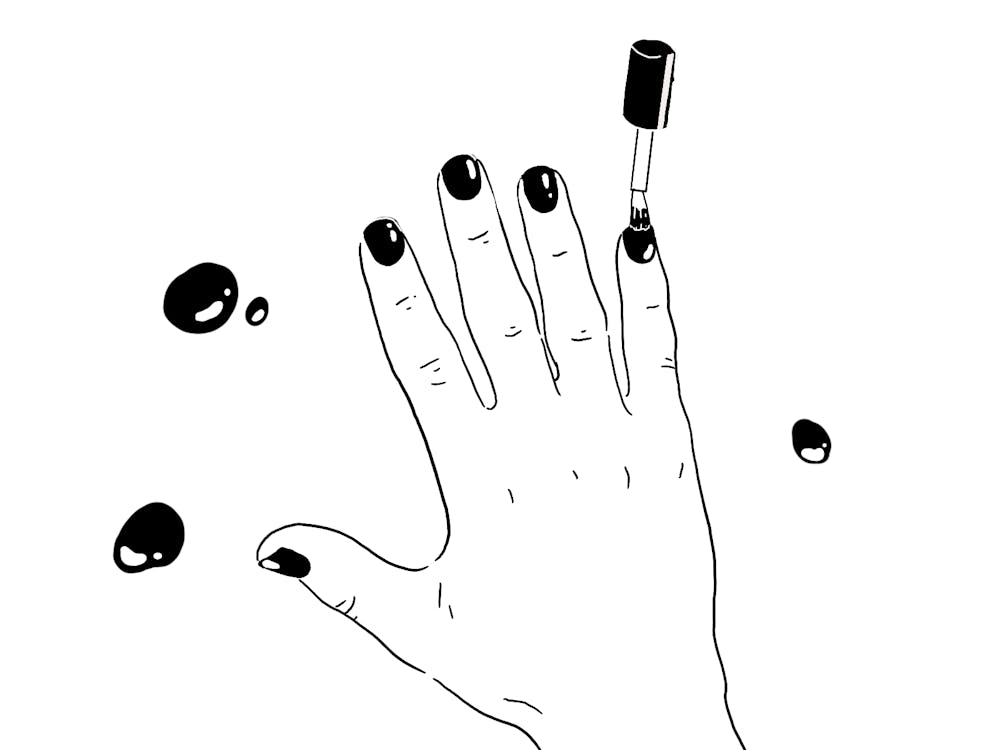“Black nails are the move [I don’t care] what anyone thinks they are so badass dont @ me,” reads a 2019 tweet from Chase Hudson, the TikTok star more commonly known as Lil Huddy, who hopped on Twitter to defend the painted nails he often sports in his viral videos.
“Badass” isn’t the word that typically comes to mind when it comes to nail polish. In fact, describing nail polish as “badass” seems, at first glance, like an oxymoron of sorts—adjectives like “dainty” or “elegant” might seem more fitting, or are perhaps more expected. Wearing nail polish has historically been categorized as a “girl thing,” lumped into the same category as wearing makeup and earrings—a category of preferences marketed as feminine and therefore wrongfully deemed acceptable only for those who identify as such.
Despite this stigma, there seems to be a recent surge in male social media stars openly painting their nails, playing with makeup, dyeing their hair, and getting their ears pierced. By doing this, they are challenging, though perhaps unintentionally, the outdated misconception that a guy doing any of these things compromises his masculinity.
A man wearing makeup, nail polish, and earrings has certainly been seen in pop–culture before—adorned by legends like David Bowie and Prince, and modern rockers like Brendon Urie and Yungblud. But this creative decision has permeated other areas of pop–culture, trickling down from the music and film industries—which have seen avant–garde and controversial style choices from stars, especially to enhance a brand or performance—to a more pedestrian and mundane platform: social media.
On TikTok and Instagram, Lil Huddy’s posts often feature his painted nails and dangling earrings. Jaden Hossler, another famed TikToker, has also adopted the trend and flip–flopped between bleached and jet black hair. Hossler also wrote in a recent tweet that he often buys and wears women’s pants, too.
In a YouTube video, Ethan Dolan, a heartthrob YouTuber, admitted to wearing cover–up to hide his acne—hopeful that his candor would inspire other boys to feel comfortable using makeup as well. Both Ethan and his equally beloved twin brother Grayson—who often sports a trendy earring and has surprised fans in the past by dyeing his dark mane an electric blonde—have also participated in YouTube videos in which they’ve had full faces of makeup done simply for fun.
And just the other day, the Sway House boys—arguably one of most influential groups of TikTokers dominating social media recently—were featured in a video with James Charles, the YouTube makeup guru. Each member helped apply James’ makeup for him, the loud and jockey boys navigating the various products and steps with unexpected ease.
It feels important to note that the aforementioned influencers are all guys one might typically classify as heteronormative and stereotypically manly, carrying themselves with virility and swagger. In recent years, men wearing makeup and participating in other stereotypically “girly” fashion trends has been popularized by social media figures like James Charles and Jeffree Star, to name a few, who are openly gay and confidently embrace their more feminine sides. But toxic masculinity often serves as a deterrent for straight men—or more generally, men who identify more with their masculine sides—to feel as comfortable co–opting these styles out of fear of being judged by their heteronormative peers and having their manliness demoted.
Yet these male social media stars are comfortably and confidently endorsing these more “feminine” style choices—and in the public eye, no less. The accessibility of social media and the relatability of its moguls normalizes this accessorization. It can’t be dismissed as simply part of a costume or performance, or part of the style of an eccentric and intangible superstar, since ordinary guys are incorporating it into their everyday looks. Seeing a TikToker like Quinton Griggs, an otherwise regular guy, sporting an earring and nail polish has a different effect than seeing pictures of the iconic, inimitable Prince doing the same.
However, that being said, many of these boys still otherwise engage in actions that perpetuate gender stereotypes—like talking about their workout grind, flashing their muscles, often posing shirtless, disclosing their sex lives, and doing dangerous stunts on camera to prove how "macho" they are. The juxtaposition of these boys' aesthetics to their actions is like whiplash. On the one hand it seems like there is potential for these moguls to help move the needle forward on gender politics, but on the other hand it seems like they still subscribe to gender stereotypes to build their public images.
It's safe to say that the positive “influence” or “impact” these social media influencers have on society is questionable, and generally seems entirely superficial. It would be nice to be able to say that these boys are helping redefine and reshape masculinity, pushing back against societal norms about how a guy should or shouldn’t look, and how a guy should or shouldn’t behave to be considered “masculine.” No doubt their style choices are a step in the right direction.
But perhaps what is also necessary is an acknowledgement of the incongruity of their aesthetic to their actions—for these boys to point out that it is, in fact, not problematic since their style should bear no indication of their gender or sexuality. It would be powerful if these boys emphasized that this aesthetic is more than just a TikTok trend. However a guy decides to dress, look, or behave, if he identifies as a man, his style choices shouldn’t make him any less of one.







